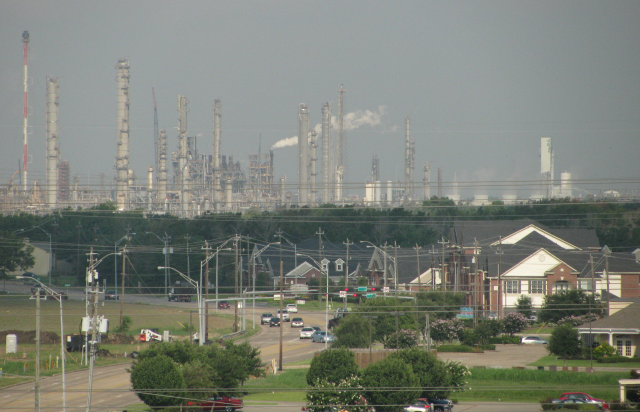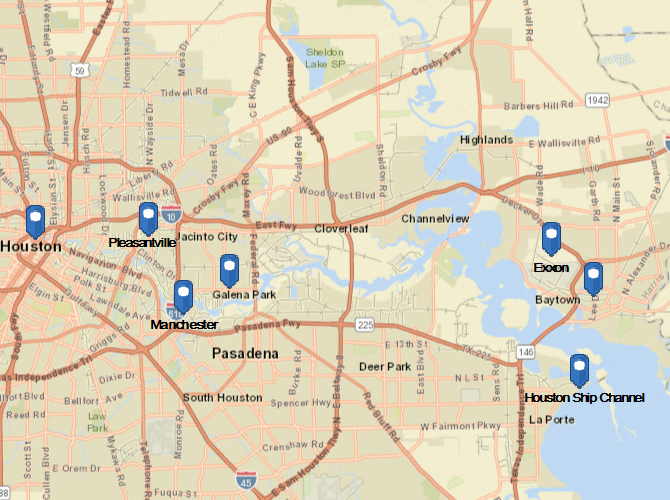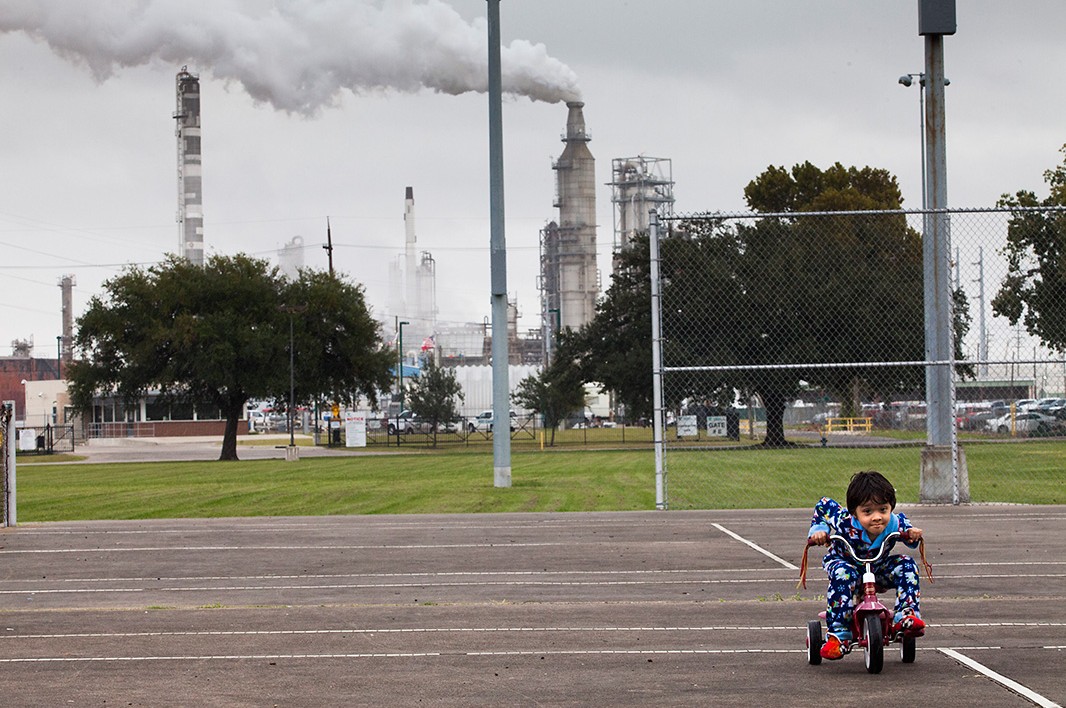
Pollution from the Baytown ExxonMobil plant affects nearby residential areas. Photo by Dave Fehling
To “start at the beginning” of the story of our victory against ExxonMobil, you’d have to go back more than seven years. To explain why it matters, you’d have to go back decades, because the pollution that makes people sick in the Houston area has been around for a long time. It is not often that legal victories like this occur, especially ones that illuminate the environmental injustices that many communities face.
If you missed the news, here’s a recap. Sierra Club and Environment Texas won a major legal victory back in April in a citizens’ lawsuit against industrial pollution in Texas when a Houston judge fined ExxonMobil $20 million for violating the federal Clean Air Act (CAA) at its Baytown refinery-chemical plant complex. The fine is thought to be the largest civil penalty ever imposed under the CAA, or any federal environmental law, in an enforcement suit brought by citizens.
The case had a number of unique aspects besides the massive fine, which make it one of the rarest wins against big polluters. To understand why, you first need to understand who is affected and what happened.
Who gets hurt by pollution

Map of polluted areas near Houston Ship Channel
ExxonMobil’s Baytown Complex is 23 miles from Houston. It has a large oil refinery and two major petrochemical plants covering 3,400 acres. It is the largest industrial facility in the nation.
Tens of thousands of people live within three miles of this complex. Emissions from the Baytown complex and other Houston Ship Channel plants drift miles, flying all the way west and northwest into the City of Houston, and into communities and neighborhoods in the East Houston area, such as Pleasantville, Galena Park, Manchester, and others along the Ship Channel. Demographic data shows that this pollution affects low-income, minority neighborhoods, which raises environmental justice (EJ) concerns. These communities are heavily underrepresented and marginalized when it comes to environmental protection, and can least afford medical care for air pollution-related illnesses.
Studies of ground level ozone (or smog), including aerial flyovers, found that the Houston Ship Channel plants like ExxonMobil’s Baytown complex are a large source of smog-forming chemicals, especially of high levels of 1,3-butadiene, ethylene, and propylene, termed “highly reactive volatile organic compounds.” Industry plays a significant role in polluting the Houston area with these compounds. These industrial chemicals create ground level ozone as they cook in the sunlight on hot days. Dozens of Houston ozone monitors measure high concentrations exceeding the federal 8-hour standard, which EPA has tightened twice since 1997 as scientific data better documents the health effects of ozone. From 2008-2017, the 8 county region around Houston has recorded nearly 400 days of unhealthy exceedances of the 8-hour EPA ozone standard so far.
Smog-forming pollution and “bad air” days have resulted in Houston ranking close to foul-air-champion Los Angeles nearly every year since the 1980s. A few years ago, Houston’s smog was so severe that it briefly topped Los Angeles for the worst 1-hour ozone problem in the nation. This was despite the convenient Gulf Coast breeze that blows Ship Channel pollution all over Houston and has given industry a lucky break for years. Otherwise, Houston would likely be worse than Los Angeles.
Why did we sue?
Sierra Club’s concerns over ExxonMobil’s Baytown facilities were due to the enormous volume of air emissions, including toxic substances like benzene, spewing from its ExxonMobil’s operations 24/7, 365 days a year. After all, ExxonMobil’s Baytown plants, when treated as one complex, have often ranked #1 in Houston and Harris County in total industrial air pollution.
Did we have to sue? Why didn’t the government do something to enforce its own laws?
Houston Sierra Club members and Baytown residents have complained to state and federal officials over the years about ExxonMobil’s toxic pollution and frequent flaring events at its sprawling Baytown site. Complaints were filed with regulatory agencies including the TCEQ, which has primary jurisdiction over ExxonMobil’s pollution. But TCEQ has often been slow to respond to neighbors’ complaints, and it issued few violations to ExxonMobil. Any fines were of the “slap on the wrist” variety. Simply put, too little was done to require ExxonMobil to fix its problems as the law requires. TCEQ has a history of lax enforcement as a way to encourage industry to move to Texas.
In the last decade, ExxonMobil’s Baytown facilities have frequently contributed to hundreds of days with bad air quality in East Harris County and into the City of Houston while paying fines as a cost of doing business. ExxonMobil Baytown has been polluting the region for decades and routinely emitting numerous chemicals above its permit limits during plant upsets and other events – the Baytown Complex averaged more than one polluting upset event per day for eight solid years (2005-2013).
Companies need to be held accountable when the TCEQ fails to enforce clean air laws in Texas. This is critical in Houston because the Ship Channel has the largest concentration of oil refineries and chemical plants in the nation, and is inundated with large emissions of benzene and other air toxins according to the EPA’s Toxic Release Inventory data. When the Houston Ship Channel plants experience massive flaring events, with flames and lengthy smoke plumes, the ozone monitors begin to light up miles away, indicating polluted air is wafting long distances from these industrial sources of pollution.
The basis of the lawsuit
Our landmark victory came nearly seven years after we filed the lawsuit in December 2010. We sued ExxonMobil over violations stemming from roughly 4,000 “upset” events (equipment breakdowns and failures, electrical failures, operator errors, etc.) that released illegal levels of toxic chemicals into the air, particularly from more than 25 elevated flares that frequently release plumes of smoke and fail to efficiently incinerate the air toxics, VOCs like benzene, and hydrogen sulfide. Uncombusted toxic chemicals such as benzene, tiny soot particles, and respiratory irritants like sulfur dioxide and nitrogen oxides can be harmful to public health!
The CAA violations totaled more than 10 million pounds of unauthorized pollution over the eight years covered the by statute of limitations in the case. However, the case did not even address ExxonMobil’s legal emissions – normal or routine daily air pollution – that are often even larger in volume (in millions of pounds every year).
ExxonMobil’s violations were for exceeding legal limits on emissions of harmful chemicals such as benzene, sulfur dioxide, hydrogen sulfide, sulfuric acid, hydrochloric acid, nitrogen oxides, carbon monoxide, soot (fine particulate matter less than 2.5 microns in size, known as PM2.5), and ozone-forming volatile organic compounds. Benzene and 1,3-butadiene are known human cancer-causing agents. There is no safe level for these carcinogens, and City of Houston officials have long expressed concerns about benzene and 1,3-butadiene pollution drifting all the way down the Ship Channel from industry into the city. Pollutants such as sulfur dioxide, sulfuric acid and hydrochloric acid mist, nitrogen oxides, and soot particles also irritate the lungs, especially impacting the health of vulnerable children who spend lots of time playing outdoors and breathe more rapidly than adults. Smog from volatile organic chemicals and nitrogen oxides also make it hard to breathe in Houston on high ozone days.
A citizen suit?
Our lawsuit was a citizen enforcement suit (as opposed to a suit brought by the government), which is allowed under the CAA when the government is not adequately enforcing the law. Citizen suits against large corporate air polluters are not that common because of their complexity, the time and expense involving in litigating them, and the seemingly unlimited legal resources of the polluters. To file a lawsuit of this magnitude required thousands of hours of time from lawyers and expert witnesses: performing legal research and factual investigation, taking depositions of witnesses, writing legal briefs and appearing in court. For an individual or family to take on big polluters would be daunting. Indeed, there aren’t even many law firms in Texas with enough resources to take on work of this magnitude.
Fortunately, groups like the Sierra Club can file a citizen suit on behalf of their individual members who live close to a polluting plant and who are suffering from the illegal pollution. Sierra Club had several Baytown members who agreed to give testimony at trial about ExxonMobil’s pollution of their neighborhoods.
In citizen suits, timing matters a lot. Polluters could be violating the Clean Air Act for many years, but the violations that the lawsuit covers can only go as far back as five years from the date the citizens send their notice of intent to sue. In our case, it was five years before July 2010, back to July 2005. The ExxonMobil Baytown Complex violated various emission limits in its permits more than 16,000 times between 2005 and the time of trial – and kept on violating even as the trial took place.
Another important aspect of this case was that ExxonMobil showed no interest in attempting to settle, choosing instead to fight tooth and nail every step of the way. ExxonMobil’s attorneys filed motions and used other litigation tactics to try to derail the case or get it dismissed over the course of several years before the case finally went to trial.
Exxon even went so far as to write up an enforcement order against itself and give it to the TCEQ to issue, as a way of convincing the judge that state regulators had the situation under control.
All through this time, thousands more violations occurred and were added to the lawsuit (hence, eight years of violations releasing approximately 10 million pounds of pollution from upset events).
These “scorched earth” litigation tactics can have the effect of dissuading many would-be plaintiffs from ever filing a lawsuit.
This wasn’t our first rodeo
This was the third federal CAA lawsuit launched by the Sierra Club, Environment Texas, and our legal team since 2008 targeting illegal pollution and violations of CAA permits stemming from upset events at oil refineries and chemical plants in the Houston area.
The ExxonMobil case followed two successful cases against Shell Oil’s Deer Park refinery (2009: $5.8 million fine) and Chevron Phillips Chemical’s Cedar Bayou plant (2011: $2.0 million fine). The $7.8 million in fines were distributed to non-profit groups to fund green energy programs in the Houston area and to Baylor College of Medicine to fund an environmental health clinic in the Ship Channel region. These achievements only came about after the two companies had agreed to negotiate, over several months in each case, and ultimately agree to a final settlement, so that courtroom trials were not needed. The CAA lawsuit settlement agreements were formalized as Consent Decrees that had to be approved by a federal judge in each case and entered as federal court orders. We were able to fund the above projects out of these settlements because the Clean Air Act does not require penalty payments in a pre-trial settlement to be paid to the federal government.
ExxonMobil’s much larger fine cannot be donated to non-profit community projects since it came after the trial was held and was assessed by the judge under the restrictions of the Clean Air Act. Once all appeals are over and the decision in the case is final, Exxon will have to send the penalty payment to the U.S. Treasury, where it gets deposited in a special fund that can only be used by EPA “to finance air compliance and enforcement activities,” as specified in the CAA (42 U.S.C. § 7604(g)(1).
These companies – ExxonMobil, Shell, and Chevron – operate several of the largest emitting plants in the Houston region and each ranks high in air emissions in Harris County, but they’re not alone. This year, we filed our fourth such lawsuit, against the Pasadena (Texas) Refinery, another Ship Channel facility which is owned by Petrobras – the Brazilian company at the center of a huge corruption scandal in Brazil.
The trial, decision, appeal, remand, and – finally – the fine
Baytown’s poor air quality was emphasized during the three-week-long trial conducted in February 2014. Extensive evidence was introduced to document the company’s pollution problems at the Baytown Complex. Sierra Club members and staff testified at the trial along with our expert witnesses, and ExxonMobil presented more than a dozen of its own witnesses.
Judge David Hittner ruled on December 17, 2014, that ExxonMobil was not deserving of being assessed any fine – even though he found that the company admitted there were many CAA violations at its Baytown plants as alleged in the lawsuit.
Sierra Club and Environment Texas appealed Judge Hittner’s decision to the federal Fifth Circuit Court of Appeals in New Orleans. Lawyers from Earthjustice and the University of Texas Law School’s Environmental Law Clinic pitched in, filing an “amicus” (friend of the court) brief in support of our appeal on behalf of the clean air advocacy group Air Alliance Houston, the City of Houston, and the Harris County Attorney’s office. About a year later, in May 2016, a three judge panel ruled that Judge Hittner had committed numerous legal errors. The appeals court “vacated” his decision (that is, they threw it out), and “remanded” the case (sent it back) to Judge Hittner to try again. This time, he ruled on April 26, 2017, that ExxonMobil had violated the CAA more than 16,000 times and he assessed a record $20 million fine.
“Exxon has illegally released millions of pounds of pollutants, including carcinogens (benzene, 1,3-butadiene), hazardous air pollutants, and respiratory irritants, from the Baytown Complex since 2005,” explained Dr. Neil Carman in a Sierra Club press release, May 3, 2013. “TCEQ’s lax oversight and slap-on-the-wrist penalties have left the residents of Baytown to suffer from ongoing illegal pollution.”
So why is this victory so remarkable, and so important?
This victory is remarkable because Exxon is an enormous company with incredible political power and financial resources. Its revenue in 2016 alone exceeded $218 billion. Exxon hired three outside law firms to fight us in this case – but lost, despite its virtually bottomless pockets.
This victory is important because it shows that, even if the TCEQ and the Trump EPA won’t enforce our environmental laws, Sierra Club and other citizen groups are ready and able to hold polluters accountable. We’ve now been successful at beating the biggest of the big, and the worst of the worst violators of the Clean Air Act in the Houston area – Exxon, Shell, and Chevron Phillips.

Big industrial plants trace the Gulf Coast, polluting neighboorhoods from Houston all the way into Louisiana. Photo by Eric Kanye of EarthJustice
What’s next?
We are now going after Petrobras for its violations at the Pasadena Refinery. A new CAA upset case was filed on March 2, 2017, alleging that the Pasadena Refinery had emitted a half a million pounds of illegal pollution from its 99-year-old refinery on the Houston Ship Channel. “The Pasadena Refinery stands out among Texas oil refineries because of the huge amounts of particulate matter that are repeatedly belched from the facility, in violation of legal limits,” explained Dr. Neil Carman. “Just recently, the company reported that two separate emission events released over three tons of particulate matter into the air, and this past July, a single emission event spewed another 21 tons of the stuff into surrounding neighborhoods.”
According to the EPA, 75,000 people live within a three-mile radius of the plant, along with at least eight schools, at least one Headstart program, and several daycares.
Particulate matter is a mix of microscopic particles and liquid droplets, including acids, organic compounds, metals, and other dust. According to the U.S. EPA, particulate matter exposure is linked to a range of serious health problems, increased emergency room and hospital visits, decreased life expectancy, and aggravated asthma.
We can’t do this without people willing to speak up
Houston area Sierra Club members have had good reasons to be concerned about the air pollution. Longtime leaders Brandt Mannchen, Frank Blake, Evelyn Merz, and others have spent the last thirty years publicly speaking out against the poor air quality of the Houston area at state ozone meetings to reduce unhealthy smog. In fact, annual emissions data at the TCEQ reveals that one of the biggest culprits for Houston’s notoriously bad air has been millions of pounds of legal and illegal air pollution released at ExxonMobil’s Baytown plants.
The ExxonMobil suit highlights why Sierra Club’s Lone Star Chapter has made clean air a top priority in Texas when industry breaks the law. The Lone Star Chapter especially prioritizes Houston, as it has suffered from a history of toxic smog and the worst air quality in Texas and the nation.
If you believe in this work we are doing, please donate to the Sierra Club’s Lone Star Chapter so we can continue to hold big polluters responsible for the air pollution impacts they have on frontline communities and beyond. We cannot do this work without contributions from people like you who do not believe in industrial “sacrifice zones”, who want clean air for everyone, and who want justice for the people who bear the brunt of toxic pollution. Together, we can make a cleaner, more prosperous Texas for everyone.
DONATE

The Valero plant in Manchester, TX is the backyard neighbor to many families. Photo by Eric Kanye of EarthJustice